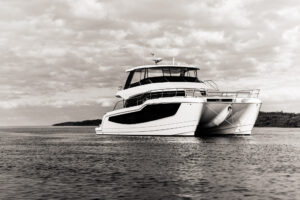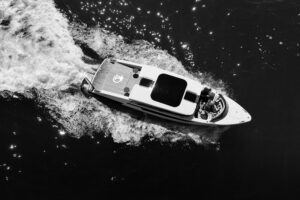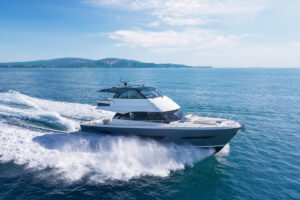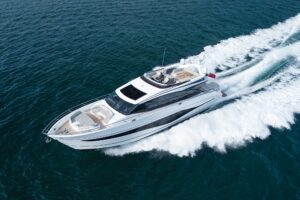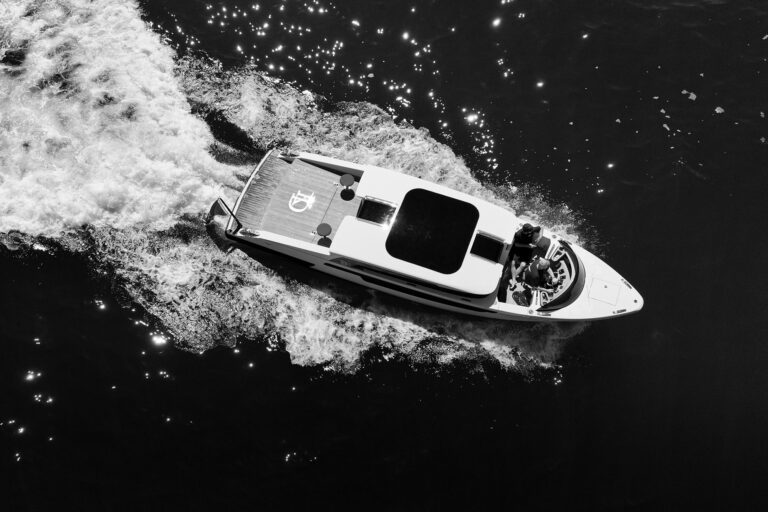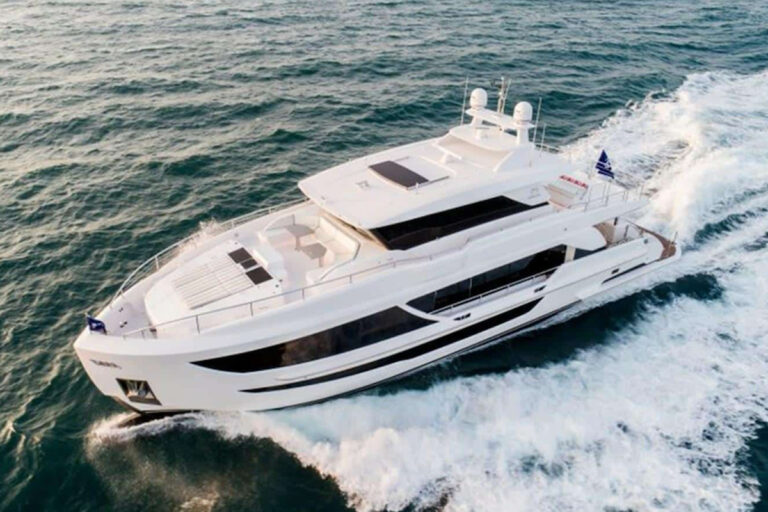I caught a glance of the Viking Sport Cruisers 84 the day before my sea trial, across the harbor at a local marina. Her graceful mass stood out in the gray Plymouth waterfront sprinkled with sailboats and a host of smaller Princess and Viking Sport Cruisers on sea trials. Doug Culverwell, national sales manager for Viking Sport Cruisers, was as excited as I was about the new flagship and wanted a sneak peak, but Clive Brooks, sales administrator for Marine Projects (the U.K. builder of Princess and Viking Sport Cruisers), shot down the request. He knew crews were finalizing last-minute details.
Finally, the next morning, the pain of waiting was over. “I hope it’s rough out there,” Culverwell quipped, confident in the 84’s seakeeping ability.
We forged ahead in Plymouth Harbor on a course for the unsettled English Channel, which was churned up by the blustery February weather. Pushing the 1,800 hp 16V2000 MTU/DDC diesels to 1500 rpm lifted the 84 onto plane effortlessly, with no tabs applied. She simply refused to squat into the green water, thanks to a flatter section in her upper tunnel surface that almost eliminates the need for tabs, except in the 13- to 14-knot range.
Culverwell got his wish. White water sprayed skyward at the breakwater, and the 84 climbed on top of the 6- to 8-foot swells, mocking them as she sprinted to 31.7 knots. The cold air sliced across our faces but failed to force any water on board, as the curved edge of the forward strakes threw spray down and away from the decks. The whistling wind was far louder than the engines or vibration. In fact, the decibel level on the bridge never passed 65. At full throttle, we banked the 84 hard over, turning her within her own wake. A few of the other Princess crews on sea trials looked on in quiet admiration of their new flagship.
Our faces suitably windblown and numb, we made our way to the lower station through the after staircase. The enclosed pilothouse comforted our chilled bodies, and we settled into the two adjustable helm seats, both positioned for maximum visibility. A U-shape settee dominates the port side of the pilothouse, and a day head is tucked in the starboard corner. (In an example of the usually minor annoyances found on the first hulls of a new model, the head’s shallow basin tended to throw water on the floor when anything more than a trickle came out of the faucet.) The large dash incorporates a crawl space under the helm with access to the back of the electronics, eliminating the need to rip the dash apart for minor repairs and service. Blinds are controlled by the push of a button, which some captains may find gimmicky.
Abaft the pilothouse, the galley can be isolated from the dining area with an electrically powered divider. There is plenty of counter space and a full array of appliances. A side door allows crew to access the galley without disturbing guests in the saloon.
The light cherry finish on the upper deck glowed in the early winter light, while the soft upholstery provided a pleasing contrast with the varnished surfaces. During construction, each component and piece of furniture is built to a specific hull number, ensuring a close, if not perfect, match of wood color and grain. CAD software is linked to a CAM machine that cuts the furniture, resulting in auto-like tolerances.
Hull number one has a large, U-shape settee in the saloon. For a more formal ambience, a sectional sofa is offered. An entertainment center with flat-screen TV is sculpted into the saloon’s starboard side. The sliding door that opens to the afterdeck brings in natural light.
While checking out the lower deck, I repeatedly told Culverwell the yacht felt bigger than 84 feet. The Marine Projects designers, by pinching space from the crew’s quarters forward and from the engineroom aft, incorporated four spacious staterooms. If the owner plans to charter, this layout is ideal. The suite-like master stateroom will seduce even the most fastidious owner. A TV/VCR, refrigerator, queen-size berth, settee and vanity are standard, and a large, sunken jacuzzi tub is sure to pamper. The sound level in the cabin at cruising speed was only 72 decibels at the headboard. Generator noise at the dock was barely distinguishable.
The forward VIP stateroom is appointed at the same level of quality as the master. Two guest staterooms with twin berths are also forward, and Viking will work with owners to create office space, change the berth arrangement or add other personal touches.
“As long as you don’t change the tray molds, we’re open to almost anything,” Brooks said.
The crew’s quarters on our test boat were accessed from the foredeck, not an appealing option when a sleepy mate is coming on watch for the graveyard shift. An alternate layout offers access from the interior. The quarters are a little tight, but should be fine for two people.
Bilges with 4-inch limber holes are finished to a glossy white and offer easy systems access. An isolated compartment under the VIP stateroom can serve as the 84’s basement, ready to swallow empty luggage and stores. The separately zoned 24-volt electrical system lets the captain isolate problems, so tracing a short should be fairly easy.
The Viking Sport Cruisers 84 is built with a handlaid, solid fiberglass hull. The superstructure is solid glass with high-density foam used in some areas. During the lay-up stage, each hull is subjected to a series of quality-control reviews. A team assigned to the hull takes core samples, sends one out for testing and keeps the other in-house. The team is responsible for future problems that may arise.
Marine Projects hand-rolls the gelcoat after spraying it. By squeezing out all the air by hand, according to the company, there is less likelihood of air pockets caused by spraying alone.
That the boats have had no blisters or delamination in 15 years backs that line of reasoning.
An aluminum grid system forms the base of the flying bridge, allowing sweeping overhangs and adding strength to carry a tender on the upper deck. It also eliminates the need to include a support post for the davit, which often protrudes on valuable afterdeck space.
Walking on the flying bridge, I strained to see beyond the harsh clouds looming over the English Channel, trying to picture myself sipping a cold drink while shrimp simmered on the barbecue. A U-shape settee, a bar and a sunpad translate to warm weather fun. The captain has full command of the 84 from the centrally located helm chair. Electronics are well laid out, and the line of sight over the bow is excellent. A station on the afterdeck helps when docking in tight quarters.
Looking to warm up, Culverwell, Brooks, the captain and I huddled into the engineroom. The space is compromised in favor of the accommodations, but systems are serviceable. The standard 1,485 hp DDC 12V2000 could free up a little more space if the buyer is willing to sacrifice some speed. If major service is needed, a soft patch in the afterdeck enables an engine to be lifted.
“We know it works. We’ve done it,” Brooks said of an engine MTU replaced. “It took a day to get it out, and an hour to get the new engine back in.”
A separate compartment abaft the engineroom houses the two 27.5kW Onan generators and pumps. Four marine-grade alloy fuel tanks totaling 2,220 gallons are forward. A complete fire protection system with a remote engineroom air shut-off and a remote fuel shut-off provide additional safety.
Touring the Marine Projects factories in Plymouth with Culverwell and Brooks, I quickly learned Viking Sport Cruisers are not simply regurgitated Princesses. Culverwell pointed out the changes made to Vikings to conform to ABYC build codes and to appeal to the broad, varied U.S. market.
Once a month, a container of appliances, electronics, equipment and other Americana leaves New Jersey bound for Plymouth. Changes to the layouts accommodate U.S. preferences, and Viking Sport Cruisers President Tom Carroll sits on the design board to ensure these cruisers are all Viking. Both yards absorb ideas and often apply them to their other lines. New product launches are coming rapid-fire, with the Sport Cruisers 84 following the winter 2000 debut of the V-65 and January’s unveiling of the 50 Motor Yacht at the New York International Boat Show.
The price of our test boat was about $4.6 million, but the Viking Sport Cruisers version will include a far more extensive list of equipment. Expect to pay more, though the price should be competitive with similarly styled and equipped custom yachts. Unlike some one-off builds, however, you receive the benefit of support from Viking and its comprehensive dealer network. That’s worth thinking about.
Contact: Viking Sport Cruisers, (609) 296-6000; fax (609) 296-7139; www.vikingsportcruisers.com.

